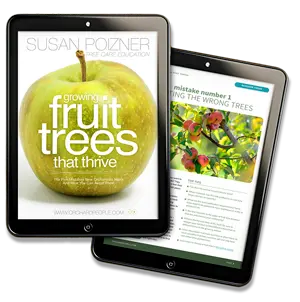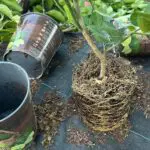How do you choose fruit trees that will work for your landscape? This article and video show you the tips Read more
Let The Sunshine In: Indoor Lemon Tree Care

You may live in a cool climate, but that doesn't mean you can't enjoy the pleasure of growing a lemon tree. Here in Canada, tropical trees planted outdoors will not survive our harsh winters. But growing lemon trees indoors is possible.
In the winter, the blossoms are so fragrant that they can make you forget the frosty weather outside. And in the summer, you can take your potted lemon tree outdoors where it will enjoy full sun and continue to delight you with a lemony harvest.
So in this article, we'll explore indoor lemon tree care. And the first consideration is to make sure you have the right indoor location for your tree.

What Kind of Light Do Indoor Lemon Trees Need?
One of the most important factors when considering indoor lemon tree care is access to sunlight! All lemon trees need LOTS of sun. I placed my potted Meyer lemon tree in a huge east facing window where it could soak up the morning light and it thrived.
Steve Biggs, author of Grow Lemons Where You Think you Can't, explains that his lemon trees thrived in his old house where he grew them in an unheated sunroom.
The temperature would dip down to just above freezing in the wintertime. It was cold, but Steve says "it was really bright and the lemons just loved it."
So place your indoor lemon tree in a very sunny spot with an average nightly temperature of about 65 degrees F (or 18 degrees C). Keep it away from air conditioning or heating ducts as extreme temperatures can stress your tree.

Keep Your Tree Compact with Root Pruning
My experience growing a lemon tree indoors was a success in the first couple of years. The tree was beautiful and produced a wonderful harvest. But the room it was in was small, and after a couple of years our lemon tree grew larger and dominated the space.
My mistake was that I didn't root prune the tree to keep it compact, according to Steve.
Every three or four years, he removes his lemon tree from its pot and gives its root system a gentle trim with his hand pruners. Then he replants the tree into the original pot.
Trimming the roots slows down tree growth but still allows the lemon tree to have enough energy to produce a good sized harvest. Steve's goal is to keep his trees small so they are easy to move outdoors in the summer and indoors in the winter.
“I want to keep them in the same size pot," he explains. "They can only get so big and be easy to lift.”
But what if you do want your indoor lemon tree to grow larger? You can repot your tree into a slightly larger pot. When you buy a lemon tree from a nursery, it will probably be in a pot that is 12 inches in diameter. You can replant it in a pot that is the next size up at about 14 inches in diameter.
When repotting, ensure that any extra soil you add will be suitable for your tree. It's best to use a well-draining potting mix that is specifically designed for citrus trees.
Fruit Trees
That Thrive

When is the Best Time to Root Prune Your Potted Lemon Tree?
The best time to root prune or repot your indoor lemon tree is early spring through to mid-summer. At that time of year the tree's roots are actively growing and they will quickly expand into the fresh soil to take advantage of the moisture and nutrients there.
Repotting your tree in winter is not ideal because the tree's roots aren't growing much during the winter months and so they won't expand into the fresh soil. Without active roots to suck out the moisture, the fresh soil may stay damp after watering. And soggy soil can cause root rot and can kill the tree.

Indoor Lemon Tree Fertilizers
All potted plants need nutrition and fertilizer to keep them healthy. But choosing the right one for an indoor citrus tree can be tricky.
“If you’re growing things in containers, you must be prepared to feed them,” says Biggs. “Start with one general purpose product. Try it out, see how it works. Most times it will work.”
There are many different types of organic fertilizers and some say they are specifically for citrus trees. Biggs suggests growers read fertilizer labels carefully because if you use the wrong type of fertilizer - or if you use too much of it - it can damage your tree.
The problem is that your lemon tree's fertilizer needs are dependent on the type of soil you use. For instance, if your soil is too alkaline, the plant will not be able to absorb some of the necessary nutrients from the soil and your lemon tree may become iron deficient.
If your lemon tree is deficient in iron, you will find that the young leaves will turn yellow, while the veins stay green. If that happens, you may need to use a more acidic fertilizer, or iron supplements made specifically for plants.

Indoor Lemon Tree Care During the Summer
During the summer, many growers take their indoor lemon trees outside onto a sunny balcony or patio where the tree can benefit from fresh air and natural sunlight.
If you have some outdoor space, that's a great thing to do... but for a tree that hasn't experienced direct sunlight for months, the extreme change in temperature can be stressful.
In addition to that, If you put an indoor lemon tree out in full sun, the hot sun can damage the bark, leaving a crack or wound in the tree. This can provide an entryway for pests and disease spores.
So Steve Biggs suggests that you can prevent sunburn by slowly acclimatizing your tree. First put it in a shady part of the garden. Once it has adjusted, you can move the tree to sunnier spots until it's ready to enjoy full sun.

choose the right variety for easier indoor lemon tree care
Are you ready to go out and buy an indoor lemon tree for your home? Great! The fun part is choosing a cultivar that will be easy to grow indoors. One popular variety is Meyer lemon trees, a cross between a lemon and mandarin orange.
But there are lots of other exotic options, like the creepy looking Buddha's Hand lemon tree that looks like a yellow hand. While Buddah's Hand lemons aren't very juicy, they are prized for their zesty pith which tastes lemony with a hint of lavender.
There are fruit tree nurseries that specialize in tropical fruit trees for indoor growers. In episode 42 of Urban Forestry Radio, Byron Martin, owner of Logee’s Plants for Home and Garden explains how they carefully select easier-to-grow varieties. Byron is also the co-author of the book Growing Tasty Tropical Plants in Any Home, Anywhere.
In the podcast, Martin shared his top tips for keeping indoor tropical fruit plants healthy and productive. He also shared his favourite tropical fruit plants that are easy to grow indoors including Calamondin Orange, Dwarf Pomegranate, Kumquat and even Coffee plants.
Learn Indoor Lemon Tree Care in this Podcast
Really, lemon trees aren’t too different to grow from other fruit trees, Biggs says. You can learn how to grow lemon trees indoors by listening to an interview with Steve Biggs in the podcast below. With the right attention and preparation, you too can grow your own lemon tree, wherever you may live.

Susan Poizner
Learn more about Susan on the about us page.



